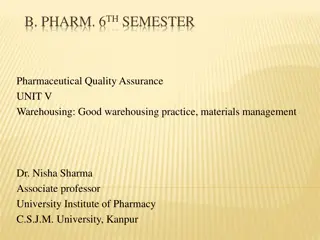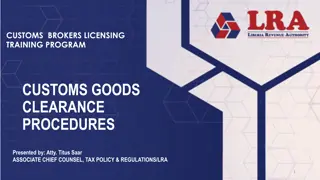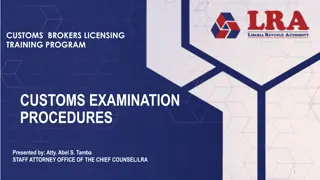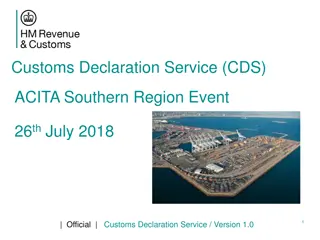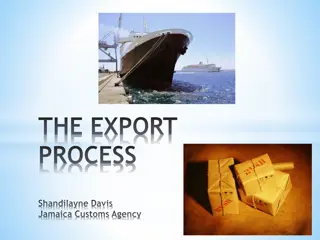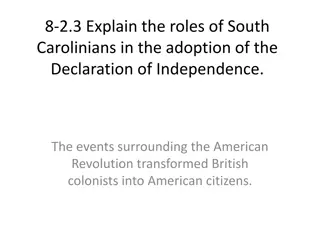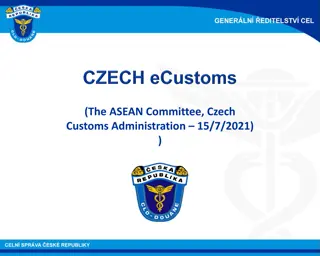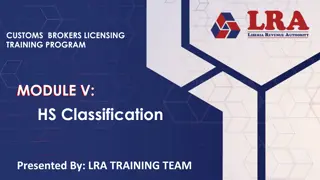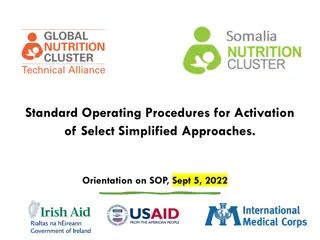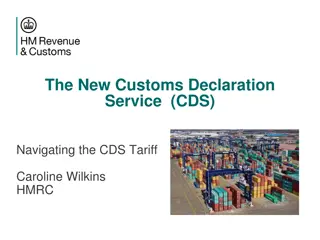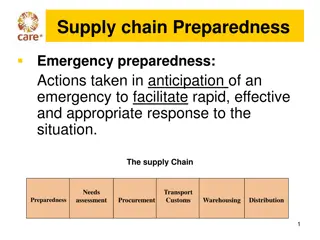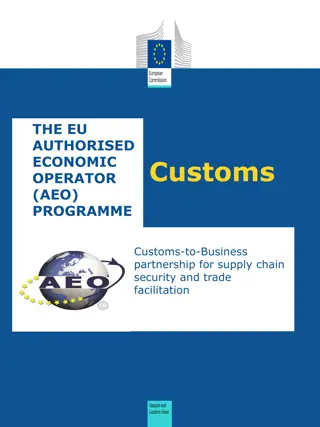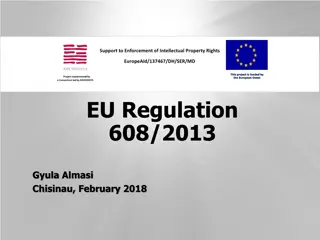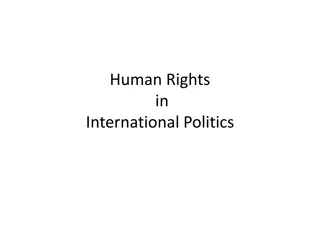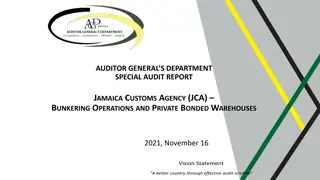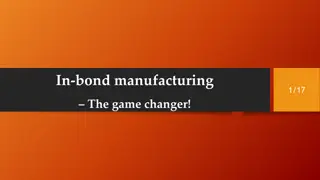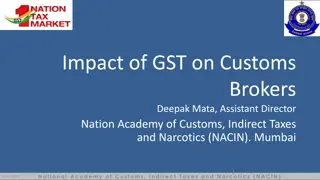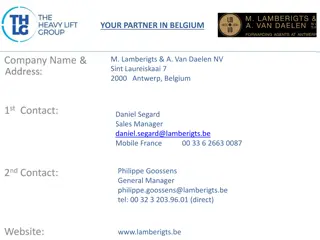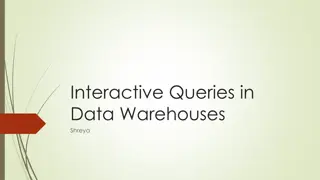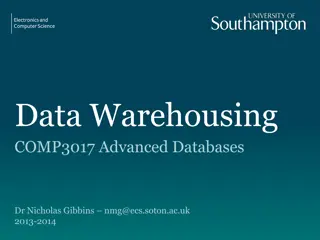Understanding Customs Warehousing and Simplified Customs Declaration Procedures
Customs Warehousing is a special procedure that allows goods to be stored in the UK while customs duties and import VAT are suspended. It aims to facilitate trade by providing duty suspension for businesses importing goods from other countries. Additionally, the Simplified Customs Declaration Procedures (formerly CFSP) streamline the declaration process for authorized traders and customs agents. Learn about eligibility criteria, types of warehouses, and the benefits these procedures offer to businesses importing goods into the UK.
Download Presentation

Please find below an Image/Link to download the presentation.
The content on the website is provided AS IS for your information and personal use only. It may not be sold, licensed, or shared on other websites without obtaining consent from the author. Download presentation by click this link. If you encounter any issues during the download, it is possible that the publisher has removed the file from their server.
E N D
Presentation Transcript
Special Procedures Customs Warehousing OFFICIAL OFFICIAL
Customs Warehousing Customs Freight Simplified Procedure (CFSP) is a simplified declaration procedure used by authorised traders and customs agents when they import goods into the UK. CFSP has had a rebrand since the UK left the EU and is now called Simplified Customs Declaration Procedures (SCDP). You may see this reference in the future. The idea behind CFSP is to provide greater flexibility to businesses by minimising border controls. Traders who are authorised to use CFSP only need to give minimal information at the border and can clear their goods quickly. For the vast majority of goods imported using CFSP, any controls or checks will be carried out by HMRC post-clearance inland rather than on entry at the frontier. Since its introduction, CFSP has proved extremely popular with importers and now accounts for over three-quarters of all entries processed by the Customs Handling of Import and Export Freight (CHIEF) computer system. Traders and customs agents who wish to use CFSP must be authorised by HMRC. OFFICIAL
Customs Warehousing Customs warehousing is a Special Procedure which allows goods brought into the UK to be stored while the customs duties and import VAT are suspended. Its aim is to facilitate trade by providing duty suspension for UK businesses importing goods from other countries. There are approximately 1,000 customs warehouses currently authorised across the UK. A wide range of goods pass through this procedure with a total annual revenue value of approximately 14 billion. Customs warehouses need to be authorised by HMRC. Unlike the other Special Procedures, once authorised, there is no time limit on the period of validity of a customs warehouse. Why would you want a Customs Warehouse? Categories and Types of Customs Warehouse Although the term 'warehouse' conjures up a vast storage shed and many customs warehouses are just that a customs warehouse doesn't have to be a building. The most common reasons for these to enter a customs warehouse are that: at the time of import the trader doesn't know the ultimate destination of the goods and wants to delay having to declare them to a specific customs procedure For example, it could be: a safe the goods don't have the necessary supporting documentation available at the time of import. For example, the importer may be waiting for import licences or tariff preference certificates a storage tank a silo the goods were originally imported to another duty suspensive procedure such as Inward Processing (IP) or Temporary Admission (TA) and are being warehoused prior to re-export from the UK a compound a designated office space the goods are going to be processed under IP at a later time a commercial accounting and inventory control system the goods had been released to free circulation but are now subject to a claim under the rejected imports arrangements and are being warehoused prior to being re-exported or discharged to another customs procedure Whatever it looks like, a Customs warehouse can either be public or private: A public warehouse is one where the warehouse keeper s main business is the storage of goods placed under customs warehousing by others (known as depositors). the trader wants to delay payment of import duty and/or import VAT on their stock of non-UK goods. A private warehouse is one where the warehouse keeper themselves is the depositor. OFFICIAL
Customs Warehousing Eligibility To use Customs Warehousing you must: be established in the UK have an Economic Operator Registration Identification (EORI) number be financially solvent and have a compliant customs record not have other operations which predominate over the need for storage in the designated area have a genuine economic need for the warehouse comply with all the legal obligations and conditions required under the authorisation have inventory records that are adequate to verify the receipt, storage, handling and disposal of the goods have records that can, at all times show the current stock of goods and location of goods under the procedure OFFICIAL
Customs Warehousing Roles & Responsibilities HMRC Depositor Warehouse Keeper There are a number of different teams within HMRC that have certain roles where customs warehousing is concerned. Here is a brief introduction to the main ones you are likely to come across: The warehouse keeper is the person who is authorised to operate the customs warehouse. The depositor is the person who is bound by the declaration placing the goods under the customs warehousing procedure. They are responsible for: The depositor is always responsible for the movement of the goods from their entry to the procedure until the goods are entered in the customs warehouse stock records. They must ensure that the goods are sent directly to the warehouse. the security and proper control of the warehoused goods including stock records for those goods and accounting for any shortage The Authorising Office Receives and processes applications for customs warehousing. The Supervising Office Is the office that is indicated in the customs warehouse authorisation as being responsible for supervising the customs warehousing arrangements (normally co-located with the authorising office). fulfilling the obligations that arise from the storage of the goods covered by the customs warehouse procedure Where a public warehouse is concerned, the depositor is responsible for providing the warehouse keeper with all the necessary details of the declaration to the customs warehouse procedure. ensuring the conditions of the customs warehouse authorisation are met The Customs Warehousing Unit of Expertise Provides technical advice and support and assists with the preparation and issue of customs warehousing authorisations. fully cooperating with HMRC in the supervision of the authorisation In a private warehouse, the depositor is also the warehouse keeper, and so will have those responsibilities too. The Pre-clearance Team Processes entries received to customs warehousing, and processes UK manual declarations for goods removed from customs warehousing. allowing HMRC access to the warehouse premises, records and goods covered by the authorisation at all reasonable times. The National Duty Repayment Centre (NDRC) Process applications for repayment of duties resulting from post clearance amendments to/or from customs warehousing. Keeping stock records of all the goods placed under the customs warehousing procedure mentioned in the first bullet point above is a very important responsibility and key to successfully running the warehouse. The CHIEF Operations Team Issue customs warehouse authorisation numbers and update management systems and databases relating to customs warehousing. OFFICIAL
Customs Warehousing Declaration Process Under the full entry procedure, traders importing goods into the UK from third countries make a full declaration when goods arrive at the frontier on a C88 (Customs Declaration). This entry is normally submitted electronically using CHIEF by a freight agent acting on the importer s behalf. The procedure under CFSP is different in that it uses a two-stage declaration process. Stage 1 Stage 2 Traders must follow up the simplified declaration with a Supplementary Declaration (SD) giving full details of the goods. The first stage involves the AO sending an initial message to Customs when the goods arrive at the frontier. This is called a Simplified Frontier Declaration (SFD). It just gives basic information and must be done electronically. They have to submit the SD within a certain time period, normally by the 4th working day of the following month (different rules for excise goods). The declaration is a completely electronic process, with all information being exchanged between the trader s systems and CHIEF. Traders can buy declaration software they need for their systems to communicate with CHIEF. Although this procedure is electronic, traders still need to keep hard copies of some documents, for example preference documents, for audit purposes. After making the SFD, authorised traders can remove goods from the frontier and either: Release them to free circulation, or to a customs procedure via Simplified Declaration Procedures (SDP), Move them under transit to local authorised premises for clearance under Entry into Declarant s Records (EIDR) OFFICIAL
Customs Warehouse Process Map Questionnaire returned by customer Full face vet/compliance checks undertaken Site Visit arranged, report completed Customer Completes SP2, send to Authorisation & Returns Team Record CCG decision as passed Authorisation decision to be made Checks Passed, Go live date agreed Applications reviewed, basic legal checks completed Application accepted. Questionnaire issued to Customer Verification/Fiscal Risks Checks Re CCG status completed Draft Authorisations documents sent to customer for completion Customer returns signed and completed documents HMRC systems updated, approval granted Legal Checks failed Fiscal checks Failed Checks failed, RTBH letter issued to customer Checks failed, RTBH letter issued to customer Application rejected, non acceptance letter issued Refer for further verification with caseworker OFFICIAL OFFICIAL
Customs Warehouse Application Process Step 1 Applicants use Form C&E48 (Simplified Procedures Application) to make the application and submit it to either BT&C or LB, who will make the decisions on authorisation. Amongst other things, the form asks for details of the business, how the duties will be secured and which of the simplified procedures (SDP or EIDR) they'll be using. Traders will need to apply separately for authorisations relating to other customs procedures (for example customs warehousing) they want to enter the goods to using CFSP. Step 2 The application goes through a Triage process, where we assess whether a trader meets some basic criteria. These are common to all simplified Customs procedures. The principle criteria are that the applicant: is established in the UK and has a GB or XI Economic Operator Registration and Identification (EORI) applies to the correct Customs Authority has not been convicted of a serious criminal offence linked to the business activities makes the accounts related to customs activities accessible can comply with customs requirements has not, in the last 3 years, committed a serious infringement, or repeated infringements of Customs rules is financially solvent, can cover their legal commitments and is not subject to bankruptcy or insolvency proceedings has a satisfactory system of managing commercial records/transport. If the trader passes the basic criteria and provides documentation needed to progress the application, an acceptance letter is issued within 30 days of receipt of the application. If the trader does not meet any of the basic criteria, a non-acceptance letter is issued to the applicant, detailing the reason(s) why the application failed. OFFICIAL
Customs Warehouse Application Process Step 3 The Technical Officer reviews the paperwork and requests any further information required. Step 4 The Technical Officer completes a PA1 form with details to set the trader up on CHIEF. This form is passed onto the Unit of Expertise for CFSP, who validate the details and forward to CHIEF Operations. The stage is often referred to as setting up of the CHIEF Badge. Once the badge is set up, the Technical Officer may wish to carry out testing with the trader. This is to ensure the applicant s software links to CHIEF correctly and the trader/agent can successfully and accurately submit a declaration. OFFICIAL
Customs Warehouse Application Process Step 5 As part of the application process, applicants are visited by an HMRC compliance officer prior to their approval. Visit are waived for traders with AEO status. This is to make sure: their computer systems, or that of their representative, communicate correctly with HMRC's systems. that the communication links between their commercial accounting systems and their CFSP messaging systems are working satisfactorily. In addition, the officer makes sure that the commercial records have a good audit trail including full links back to the supporting documentation. Step 6 Assuming everything is all right the authorisation team in Salford or LB office issue a C&E58 authorisation letter. The trader must sign a copy of the letter and return it to the approving officer. If the importer doesn't meet the criteria, HMRC can refuse the application. In this case, the trader has a right to appeal. OFFICIAL
Who can use CFSP? Who can use CFSP? Traders and customs agents need to be authorised by HMRC to use CFSP. It is possible for a customs agent to act as either a direct (GB only) or indirect representative for import declarations. This may be important because it affects who's liable for any customs debt, so you'll look at what these terms mean next. Self-representation (SR) - there is self-representation (SR) where an authorised importer acts on their own behalf. Direct representation (DR) - this is where the representative acts in the name of and on behalf of the importer. If the trader is the CFSP authorisation holder, the representative doesn't need to be. In this case the importer remains solely responsible for any Customs debt. Indirect representation (IR) - this is where an authorised agent acts in their own name and on behalf of the importer. Examples of this are the fast parcel operators who act in their own name when importing goods for their customers. With indirect representation the agent and importer are jointly and severally liable for any Customs debt. This means that the agents could be sued independently for any debts incurred by the importer. OFFICIAL
Warehousing Warehouse Entry SDP is by far the most common way for goods using CFSP to enter a customs warehouse. The trader submits an SFD which shows that the goods are entering a warehouse and giving details. So, the goods enter the customs warehouse procedure at the frontier. When the goods physically enter the warehouse, they are entered into the warehouse stock records. These records must include details of the Declaration Unique Consignment Reference (DUCR) and SFD entry numbers and dates. The trader submits an SDI by the fourth working day of the following month that shows that the goods are in warehousing. The warehouse keeper records the SDI entry number in the warehouse stock records. Although EIDR can be used to import goods and move them into a customs warehouse, it's very rare. This is because the customs warehouse procedure itself provides a similar (and unlimited) business benefit to the 20-day delay provided by temporary storage. Most entries into a customs warehouse therefore use SDP. OFFICIAL
Warehousing Warehouse Removal EIDR is more commonly used in connection with customs warehousing to remove goods from the customs warehouse. Traders must be authorised to do it. It allows traders to make an entry in their local inventory records and means they can remove goods from a warehouse without having to submit an electronic declaration to HMRC for the goods before they can leave. The trader needs to follow up the local clearance entry by sending a supplementary declaration to HMRC, in this case called a Supplementary Declaration Warehouse (SDW) to HMRC within the normal time period of the fourth working day of the following month. Under this system, the use of EIDR must be allowed for in the customs warehouse authorisation and the procedure for removals is as follows. The trader notifies HMRC before the removal (if specified in their authorisation). The warehouse keeper enters details of the removal to a customs procedure in the local inventory records. This must include the tax point date, which establishes the base date for the submission of the SDW. If standing/dwell time is needed, it will be specified in the authorisation letter. Dwell time is a period of time between noting the local inventory records and physically releasing the goods. This time gap gives HMRC an opportunity to examine the goods some of which (like certain CAP goods) may require regular mandatory examinations. The trader submits the SDW by the fourth working day of the month after the base date month. OFFICIAL
Inward & Outward Processing Inward Processing enables businesses to obtain relief on customs duties and import VAT on goods which are imported from outside the UK, where they are processed and then exported out of the UK. IP also allows for customs duties to be suspended on goods imported to be processed and then entered to free circulation. Like Inward Processing, Outward Processing allows relief on customs duties for imports of goods from third countries where they ve been produced from previous exported UK goods. In OP you can also return faulty goods to a third country to be repaired or replaced with equivalent goods. Why would you want to use Inward Processing? It allows for relief or suspension of duties and VAT which can make the operation more economically viable Where goods remain in the UK, you can pay a reduced amount of duty and import VAT where the rate is lower than the originally imported goods Why would you want to use Outward Processing? It allows for relief or suspension of duties (but not VAT) which can make the operation more economically viable Only pay duty on the value added to the processed goods upon re-import It means you can take advantage of potentially cheaper labour costs by exporting to a third country It encourages the use of UK produced raw materials to manufacture the final product OFFICIAL
Inward & Outward Processing Things you need to know before you apply 1. Do I meet the essential criteria? For us to be able to accept your application you must satisfy the following: be established in the UK hold an EORI number be financially solvent and have a good compliance record be able to keep robust records 1. Do I have all the information ready for my application? What are you intending to do with the goods? What are the goods (commodity codes)? How many goods will you process? What is the rate of yield? How long will it take you to process the goods (throughput period)? How will you value the goods (if destined for free circulation)? Details of any other parties who will process or repair the goods (such as sub-contractors) If you want to transfer any rights or obligations Where the goods will be entered to and discharged from the procedure How will you keep robust records and where they are stored? OFFICIAL OFFICIAL
Inward & Outward Processing Authorisations How long can I be authorised? We can usually give you an authorisation for 5 years (3 years for sensitive goods). Towards the expiry date, you can apply to renew your authorisation. Authorisation Types Retrospective authorisation - If you ask for an authorisation to start prior to the date you send us the application, it is considered a retrospective application. It s possible to retrospectively apply your authorisation up to 12 months prior (but 3 months for sensitive goods). Full authorisation For regular users of the procedure. Authorisation by declaration Authorisation is applied by use of the customs declaration at the border. This can only be used up to 3 times a year with a maximum goods value of 500,000 per import. To approve this, we re required to satisfy for some checks including: For Outward Processing this can only be used for goods exported for repair. Being satisfied there are exceptional circumstances Single authorisation If processing occurs in both NI and the EU it is possible to apply for a single authorisation rather than one for each site. We sometimes call this multistate . Assurance that the goods can be identified as appropriate to the procedure Assurance that the goods are treated appropriately to the procedure OFFICIAL
What can you do within your Authorisation? There are several options to choose from and you may not need them all. These include: Rights Equivalence to process or use non-UK goods in the UK or to export UK goods for processing outside the UK In IP, you can export products made from equivalent goods in free circulation before you import the goods you need for processing or repair. This is called prior export equivalence. to move goods to the office of exit from the UK under the authorisation which placed those goods in a special procedure to re-export goods from the UK or to export goods under Outward Processing and to benefit from the import duty calculations on their return For OP, equivalent goods must be non-UK Goods, processed instead of the UK goods. Standard Exchange System (SES) Obligations This allows you to import a replacement for an item you ve exported for repair. process the goods within the time limit specified in the authorisation keep records Transfer of Rights and Obligations (TORO) keep goods available for customs supervision You can transfer some or all your rights and obligations to someone else, if you are the procedure holder. If transferring from a TOTO holder to another TORO holder, all rights and obligations must be transferred. correctly declare the goods at import and/or export under outward processing, to complete, where necessary, the appropriate INF form at export lodge a guarantee where required pay any duty due OFFICIAL
Your Responsibilities The authorisation letter sets these out in detail, but the key ones are: Ensuring goods are correctly declared to the procedure Making sure goods are discharged from the procedure in the correct time Submitting Bills of Discharge where applicable Notifying HMRC of any change in circumstances, ranging from entering administration through to using new commodity codes Maintaining robust records OFFICIAL
Special Procedures FAQs - C.W Q: Do I need to have a Customs Comprehensive Guarantee (CCG)? A: Following the EU transition (01/01/2021) a CCG is no longer mandatory for Customs Warehouses in GB. You will still require a CCG if you are operating in Northern Ireland. Please note: HMRC can request that you have one in place before we agree to authorise you. Q: What is the difference between a public and a private warehouse? A: Public warehouses store goods owned by third parties (known as depositors). Private warehouses store goods owned by yourself (the authorisation holder and the depositor are one and the same). Q: How long will it take to get authorised? A: We are currently working to a Service Level Agreement of 60 days, but this will all determine on how complete your application is at the time of applying. Q: And what does the application process entail? A: On top of the SP2 application form we require written procedures (a detailed document on how your warehouse will operate), a personnel chart, detailed site plans of the premises, a full list of commodity codes and letters of intent from your customers (if you are applying for a public warehouse). Once your SP2 and supporting documents are received, one of our caseworkers will review them and get back to you if any changes are required. Provided everything is correct, our caseworkers will then escalate your case to a visiting officer who will arrange a visit to your premises. Please note: Due to COVID, these visits may be carried out remotely. OFFICIAL
Special Procedures FAQs -CW Q:Why is the Customs Warehousing (CW) and CFSP team combined? A: Traders using CFSP, in particular SDP, often move goods straight into a customs warehouse where they can be stored under duty suspension. As CW is closely linked with CFSP, traders often apply for both authorisations simultaneously. CFSP is not a requirement for CW, however advantages of having it include eliminating the cost of making full declarations and speeding up the movement of goods. Q: Is there a minimum through put or usage required to apply for a customs warehouse? A: We determine the requirement of CW based on economic need. There is no hard cut off for this. The best thing to do is submit an application or email our team (Leeds Citex) and our team will look into this for you. leeds.citexteam@hmrc.gov.uk Q: With CFSP, the trader does not need to submit a Supplementary Declaration (SDI) for entry to a Customs Warehouse, due to the waiver allowed by DA Article 183 - is that correct? A: Yes, that would be correct OFFICIAL
Special Procedures FAQs -CW Q: Is it allowed for a trader to use EIDR for both entry to and removal from their Customs Warehouse? A: Yes you can use both EIDR into Customs Warehousing and out of Customs Warehousing as long as your systems update in real time. Q: How will the WH Authorisation process change for CDS? A: The authorisation process won't change at all. We are currently supplying all applicants with both a CW CHIEF reference and a CDS reference upon authorisation so they are future proofed for when CDS is eventually rolled out to everyone. Q: Any changes to CFSP? A: No big notable changes to how CFSP operates fundamentally since the UK transition. Two things I would highlight: If you are currently operating as an Indirect Rep, you can opt to also operate as a Direct Rep for your clients that are based in GB. The Border Operating Model advises that you can do this as default if you already hold an appropriate CFSP authorisation but you should be updating the supervising office if you have done this or intend on doing this. Email: leeds.citexarteam@hmrc.gov.uk Delayed declarations have been put in place for 2021, meaning non-CFSP authorised traders can import goods from the EU using EIDR without submitting a simplified declaration, they then have 175 days to follow this up with a supplementary declaration. This means they either need to get authorised for CFSP within that timescale or find a CFSP authorised agent to submit those supplementary declarations on their behalf. OFFICIAL
IPOP Procedures FAQs Q: What is the Processed product? A: The customer should go to the tariff checker and creates a commodity code which identifies the product and the VAT/DUTY which would be due if IP/OP wasn't in place. Occasionally, traders do not provide a description of the goods which is important or forget to provide a processed product. This may be the same CC code if the goods are repaired or it may be different if for example a piece of fabric is being made into a bag. Q: Can you provide a better understanding of Through Put Periods (TPP s)? A: The throughput period is the time you ll need to process the goods-from the date you import or receive them to the date that you ll dispose of them. The period should not exceed a year, although there are some exemptions such as repairing a vintage car. Officers use a calculator to work out the dates for when a trader should discharge their goods using a bill of discharge declaration. This is then added to the Authorisation to help the Trader understand how these periods work and when BoD s are due to HMRC. OFFICIAL
Customer Feedback To enable us to improve our service to you we would encourage you to complete the attached feedback report on this event. Please click here to access this form. OFFICIAL


